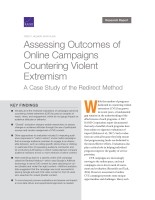| 来源类型 | Research Reports
|
| 规范类型 | 报告
|
| DOI | https://doi.org/10.7249/RR2813
|
| 来源ID | RR-2813-GNF
|
| Assessing Outcomes of Online Campaigns Countering Violent Extremism: A Case Study of the Redirect Method |
| Todd C. Helmus; Kurt Klein
|
| 发表日期 | 2018
|
| 出版年 | 2018
|
| 页码 | 19
|
| 语种 | 英语
|
| 结论 |
The unique nature of social media can impede conventional approaches to assessing program impact- Exposure to social media content is highly self-selective.
- The rapid flow of social media information across browser screens can reduce the accuracy of exposure recall.
Previous assessment efforts examined basic process characteristics- Virtually all of the reviewed CVE evaluations focused on analysis of reach, views, and engagement.
- The field is still immature; very few systematic evaluations are published, most of which are brief case-study analyses.
The Redirect Method campaign targets violent extremist content- The campaign consisted of two separate arms, one focused on targeting violent jihadist extremists and the other targeting violent far-right extremists.
- The primary goal of the intervention was to "prevent unobstructed access to extremist content."
Analysis of the results of the Redirect Method campaign focused on impression shares, clicks, click-through rates, and video watch statistics- The violent far-right campaign achieved a much higher number of total impressions, which likely indicates that, in the United States, the number of violent far-right sympathizers is larger than the number of violent jihadist extremist sympathizers.
- Results for impression shares varied significantly between the two campaigns, with the violent jihadist campaign achieving more than 90-percent impression shares, compared with 51.23 percent for the violent far right campaign.
|
| 摘要 |
- Online CVE campaign evaluators can study "open" campaigns using a social media platform's analytics to test reach and reactivity to the campaign and to evaluate other process-oriented metrics.
- "Closed" evaluation designs, which use participant surveys and random assignment to CVE content, enable researchers to assess changes in audience attitudes.
- Other approaches to evaluation include measuring audience responses to "calls to action" (social media campaigns that encourage audience members to engage in an observable behavior, such as calling phone lines or clicking on particular links); assessment of audience comments; and A-B testing, in which media planners compare audience reactions to two or more versions of online content.
- The Redirect Method should consider more-tailored options. First, it can recruit former extremists to help assess whether Google Ads and video content is entertaining, accurate, and potentially persuasive.
- Second, it might be feasible to test the impact of the Redirect Method in a closed evaluation design, drawing on a specially recruited population of participants, which would prevent the provision of survey content to viewers of the live campaign.
- A new method for analysis involves developing a sample of users who post comments on the Redirect Method's YouTube page, then assessing the comments that those users post to videos that they watch before and after watching Redirect Method videos.
|
| 主题 | Counterterrorism
; The Internet
; Racial Discrimination
; Social Media Analysis
; Violence
|
| URL | https://www.rand.org/pubs/research_reports/RR2813.html
|
| 来源智库 | RAND Corporation (United States)
|
| 引用统计 |
|
| 资源类型 | 智库出版物
|
| 条目标识符 | http://119.78.100.153/handle/2XGU8XDN/108954
|
推荐引用方式
GB/T 7714 |
Todd C. Helmus,Kurt Klein. Assessing Outcomes of Online Campaigns Countering Violent Extremism: A Case Study of the Redirect Method. 2018.
|
|
文件名:
|
x1552334586270.jpg
|
|
格式:
|
JPEG
|

|
文件名:
|
RAND_RR2813.pdf
|
|
格式:
|
Adobe PDF
|
除非特别说明,本系统中所有内容都受版权保护,并保留所有权利。